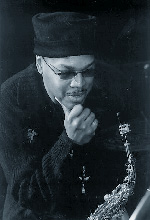
|
|
|
|
|
|
Photo Credit: Jeffrey Kliman |
Greg Osby
Greg Osby teamed up with Dr. Billy Taylor? What have we here: the ever-questing, uncompromising, innovative, and serious young alto sax player and composer performing and conversing with our affable host? Yes, indeed. And what an intriguing mix they make for this very special episode of Billy Taylor's Jazz at the Kennedy Center! In fact, Dr. Taylor in his opening commentary just about sums up Mr. Osby, whom some might refer to as a bit of an iconoclast: "Greg shows great respect for the tradition, yet he always brings his own fresh and creative spark to the music. The result: a sound that is passionate, melodic and unmistakable." A Washington connection is quite palpable for Dr. Taylor's guest, whose advanced music education began at Howard University. Osby recounts how he initially rebelled at music education, which required him to learn Western classical music and its components, such as choral music. He simply didn't see the relationship to his jazz musician aspirations. "But, interestingly enough, I use a lot of those essentials in all of my music," Osby remarks, to our audience's amusement. He eventually transferred to Berklee College of Music in Boston and found himself in the company of some of today's most vital young musicians, including trumpeter Wallace Roney, drummers Teri Lyne Carrington and Cindy Blackman, and saxman Branford Marsalis. Osby reminisces about growing up in St. Louis, a city that has produced a number of great jazz artists. As Osby tells the audience, some of his first exposure to the music came on Sundays when an insinuating neighbor would blast jazz out of his window for all the neighbors to hear -- like it or not. As a schoolboy Osby says he used to earn significant pocket change playing in R&B bands on the weekends, but the jazz sound began to take shape. Professionally his first gigs were with trumpeters Jon Faddis and Dizzy Gillespie, each of whom he connected with during his Berklee days on weekend jaunts to New York to jam. Gillespie in particular encouraged Osby to pursue the creative impulses he was hearing in his head. Osby developed a personal improvising technique he calls "shifting melodic order" that is "reflective of my sensibility towards piano. I'm more or less a frustrated piano player." To which Dr. Taylor responds, to the audience's delight: "Me too." Throughout the show Osby's methods and interesting ways of expressing the music clearly intrigue our masterful, though always open-minded and ever-curious host. The customary audience question & answer segment draws an inquiry from an obviously aspiring musician about the saxophone equipment Osby employs. The audience chuckles when she follows-up, probing further for the model number of the mouthpiece he uses. Turns out Osby uses a large mouthpiece "because I like to simulate the breadth and depth of a fat guy." After the laughter dies down he quickly adds, "I mean that in the best way," as an endeavor to develop the big sound of a large man with an ample chest cavity and a huge lung capacity.
Music for this engrossing show includes: "Back Home in Indiana," which opens with a sax/bass duet before drummer Winard Harper and Dr. Taylor swing in; Fats Waller's "Jitterbug Waltz;" the lovely ballad "I Didn't Know About You;" and the blistering closer, John Coltrane's "Impressions."
|
|
| |
